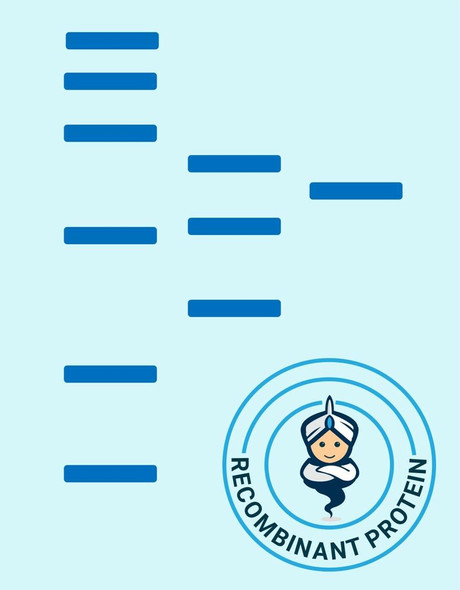Description
| Product Name: | Bovine aFGF Recombinant Protein |
| Product Code: | RPPB0214 |
| Size: | 5µg |
| Species: | Bovine |
| Target: | aFGF |
| Synonyms: | HBGF-1, ECGF-beta, FIBP, FGFIBP, FIBP-1, ECGF, ECGFA, GLIO703, FGF1, FGF-a. |
| Source: | Bovine Brain |
| Physical Appearance: | Sterile Filtered White lyophilized (freeze-dried) powder. |
| Formulation: | Each 5�g aFGF were lyophilized from 0.5ml solution containing 1mM sodium phosphate, pH 7 after filtration over a low binding membrane. |
| Solubility: | It is recommended to reconstitute the lyophilized aFGF in sterile 50mM Na2HPO4 pH-7, and 0.5% albumin. The Recommended concentration in cell culture: 1-20ng/ml. |
| Stability: | Lyophilized aFGF although stable at room temperature for 2 weeks, should be stored desiccated below -18°C. Upon reconstitution aFGF should be stored at 4°C between 2-3 weeks and for future use below -18°C.Please prevent freeze-thaw cycles. |
| Purity: | Greater than 90%. |
| Biological Activity: | Stimulates growth of bovine capillary endothelial cells by 3-5 fold over 5% calf serum at 10-25ng/ml FGF. |
Acidic fibroblast growth factor is a member of the fibroblast growth factor (FGF) family. FGF family members possess broad mitogenic and cell survival activities, and are involved in a variety of biological processes, including embryonic development, cell growth, morphogenesis, tissue repair, tumor growth and invasion. This protein functions as a modifier of endothelial cell migration and proliferation, as well as an angiogenic factor. It acts as a mitogen for a variety of mesoderm- and neuroectoderm-derived cells in vitro, thus is thought to be involved in organogenesis. Three alternatively spliced variants encoding different isoforms have been described. The binding growth factors are angiogenic agents in vivo and are potent mitogens for a variety of cell types in vitro. There are differences in the tissue distribution and concentration of these 2 growth factors.
Fibroblast Growth Factor-acidic Bovine (FGF-1) purified from Bovine Brain contains a 17 kDa and a 20 kDa polypeptide chain. The 17 kDa peptide is derived from the 20K peptide by restricted proteolysis. (See Jaye et al�). The FGF acidic is purified by proprietary chromatographic techniques.
| UniProt Protein Function: | Plays an important role in the regulation of cell survival, cell division, angiogenesis, cell differentiation and cell migration. Functions as potent mitogen in vitro. Acts as a ligand for FGFR1 and integrins. Binds to FGFR1 in the presence of heparin leading to FGFR1 dimerization and activation via sequential autophosphorylation on tyrosine residues which act as docking sites for interacting proteins, leading to the activation of several signaling cascades. Binds to integrin ITGAV:ITGB3. Its binding to integrin, subsequent ternary complex formation with integrin and FGFR1, and the recruitment of PTPN11 to the complex are essential for FGF1 signaling. Induces the phosphorylation and activation of FGFR1, FRS2, MAPK3/ERK1, MAPK1/ERK2 and AKT1. Can induce angiogenesis (). |
| UniProt Protein Details: | |
| NCBI Summary: | |
| UniProt Code: | P03968 |
| NCBI GenInfo Identifier: | 27806633 |
| NCBI Gene ID: | 281160 |
| NCBI Accession: | NP_776480.1 |
| UniProt Secondary Accession: | P03968,Q3ZBL8 |
| UniProt Related Accession: | P03968 |
| Molecular Weight: | 17,493 Da |
| NCBI Full Name: | fibroblast growth factor 1 |
| NCBI Synonym Full Names: | fibroblast growth factor 1 |
| NCBI Official Symbol: | FGF1�� |
| NCBI Official Synonym Symbols: | ECGF; EDGF; aFGF; FGF-1; HBGF-1; EDGF II�� |
| NCBI Protein Information: | fibroblast growth factor 1 |
| UniProt Protein Name: | Fibroblast growth factor 1 |
| UniProt Synonym Protein Names: | Acidic eye-derived growth factor II; EDGF II |
| Protein Family: | Fibroblast growth factor |
| UniProt Gene Name: | FGF1�� |
| UniProt Entry Name: |






